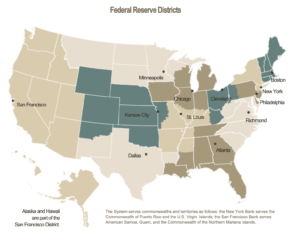Beef prices are projected to continue increasing as U.S. beef production declines with no signs of a cattle herd rebuild. Additionally, cheap beef may soon become further out of reach…
Federal Reserve: Observations on the Ag Economy- July 2022
On Wednesday, the Federal Reserve Board released its July 2022 Beige Book update, a summary of commentary on current economic conditions by Federal Reserve District. The report included several observations pertaining to the U.S. agricultural economy.

* Sixth District- Atlanta– “Agricultural conditions remained mixed. Most of the District was drought free. On a month-over-month basis, the June production forecast for Florida’s orange crop increased slightly from the previous forecast, but was still well below last season’s production. The USDA reported year-over-year prices paid to farmers in April were slightly up for cattle corn, cotton, eggs, milk, soybeans, rice, and broilers. On a month-over-month basis, prices de- creased for broilers, corn, cotton, eggs, milk, rice, and soybeans. Cattle prices were unchanged.”
* Seventh District- Chicago– “Contacts continued to expect agricultural incomes to be solid for most producers in 2022.
Despite worries about supply chain problems, inputs were largely reaching farms in time.
“Heavy rains in some areas diluted fertilizer and created ponds in fields, hurting potential yields; in other areas there were concerns about dryness and heat. Still, corn and soybean conditions were close to average for much of the District. Corn and soybean prices fell some over the reporting period, while milk prices were generally higher. After widespread flock losses from bird flu, egg-laying capacity began to return and egg prices edged down from elevated levels. Hog and cattle prices increased. Farmland prices moved higher once more.”
* Eighth District- St. Louis– “District agriculture conditions declined moderately relative to the previous reporting period and the previous year. In June, the percentages of corn, cotton, rice, and soybeans rated fair or better decreased slightly to moderately across the District. Most crop conditions declined moderately over this period relative to last year, except for rice, which increased modestly.”
* Ninth District- Minneapolis– “District agricultural conditions remained strong since the previous report. Most of the region’s corn and soybean crops were rated in good or excellent condition and progressing on schedule. However, nearly half of the Montana winter wheat crop was in poor or very poor condition, as drought conditions persisted in the Golden Triangle region.”
* Tenth District- Kansas City– “Agricultural economic conditions in the Tenth District remained strong through June. Although the price of some key commodities declined slightly from the previous month, both crop and livestock prices remained at multi-year highs.
Agricultural prices continued to support revenue prospects, but District contacts continued to voice a heightened concern about significant increases in production costs for both crop and livestock producers.
“Drought also remained a primary concern. The condition of corn and soybeans was only slightly weaker than a year ago in most states. The condition of wheat in nearly all District states was exceptionally poor and could hinder revenues for many producers.”
* Eleventh District- Dallas– “Much of the district remained in severe drought, causing agricultural conditions to deteriorate further. The wheat harvest was wrapping up and with much lower harvestable acres and yields, production is expected to be substantially below average.
Agricultural producers continued to be concerned with production cost increases and the availability of inputs. With prices and costs at high levels, producers may still be able to generate a profit, but current drought conditions create a higher-risk situation than normal.
“Ranchers continued to reduce herd sizes amid poor grazing conditions and limited hay supplies. Contacts noted that the strengthening dollar combined with higher transportation costs and logistics issues could negatively impact agricultural exports moving forward.”
* Twelfth District- San Francisco– “Conditions in the agriculture and resource-related sectors were mixed. Drought conditions in many areas adversely impacted the growing season, with some producers letting portions of their farms go fallow in order to prioritize water usage. Growers in the Pacific North-west instead reported increased precipitation, with one producer expressing concern that the colder weather would reduce crop yield. Farmers throughout the District reported increased international demand for both fresh and processed foods but noted that a strengthening dollar dampened sales somewhat.
Input costs, such as those for fertilizer, machinery, fuel, and feed, increased further over the reporting period, partially due to the continuation of the Russian invasion of Ukraine. Supply chain disruptions persisted, but many contacts reported an easing of port backlogs and shipping rates despite increased fuel costs.
“One producer in the Pacific Northwest warned declining shipping rates could indicate decreasing food sales prospects, while a contact in the seafood sector reported only minor improvement in shipping conditions.”





